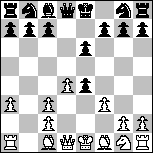
1. e4 e6 2. d4 d5 3. Nc3 Bb4 4. a3
The Winawer, Alekhine (Marsczy) Gambit, which has similar ideas, arises after 4. Ne2.
4... Bxc3+ 5. bxc3 dxe4 6. f3

6... exf3
6... Nf6 7. Bg5 h6 8. Bh4 exf3 9. Nxf3 Nbd7 10. Bd3 c5 11. O-O Qc7
12. Qe2 Nd5 13. Ne5 Nxc3 14. Rxf7!? Nxe2+ 15. Bxe2 cxd4 16. Re7+ Kf8
17. Rf1+ Kg8 18. Re8+ Kh7 19. Bd3+ g6 20. Rf7# 1-0,
Heikkinen - Kauranen, 1991
 .
This is one of my wildest games.
.
This is one of my wildest games.
6... b6 7. Bb5+ Bd7 8. Qe2 Bxb5 9. Qxb5+ Qd7! 10. Qxd7+ Nxd7 11. fxe4 Ngf6 is given as a refutation in The Big Book of Busts. However, 7. Nh3 may be better for White.
7. Nxf3 Nf6
Note that if the c2-pawn was on c4, and it were Black's move, this would be the main line of the DDG.
8. Bd3 O-O 9. O-O c5 10. Bg5 h6
11. Qe1!
Here Bischof wrote: It looks quite interesting, but will not work.
11... hxg5 12. Nxg5 Qc7 13. Qh4 Re8 14. Rxf6 gxf6 15. Nh7 Nd7
Now Bischof wrote: In this variation White can get no more than a draw.
16. Qg4+ Kh8 17. Qh5 Kg7 18. Rf1 1-0.
Bischof: We do not have to continue this game. (18... f5 19. Qg5+ Kh8 (19... Kxh7 20. Rf3) 20. Qh6 Kg8 21. Rf3 cxd4 22. Qg5+ Kh8 23. Rh3), Thomas Winckelmann - Bischof, corres 1991, Game 1905.
Unlike many other gambits it seems that Black gets the biggest problems when accepting the pawn. Winckelmann has made a small saying that in translation would go like this: Take the pawn, it has been tried, but comes near to suicide!
The position after 7. Nxf3 should seem familiar to BDG players. It resembles very much a position arising from the Euwe Defense and the differences seem to be in White's favor: The d4-pawn is now safely guarded and the Black bishop is no longer available for the defense on the kingside. White almost invariably plays 8. Bd3 and 9. O-O and also the frequently played maneuver Qe1-h4 is well known to us.
3 games in PGN (out of 8 published in the original article).